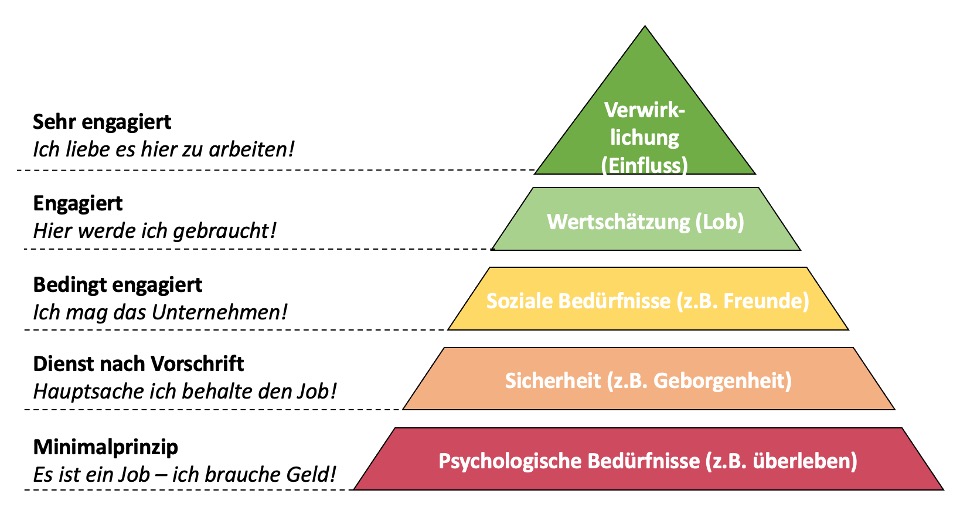Employees are an important asset and skilled workers are heavily promoted in the market. It is therefore important for companies to retain employees through more than just a salary. But how can this be achieved? Of course, there are numerous recommendations on the Internet such as company celebrations, after-work events and much more – but the question is: How are these measures related and how exactly do they increase employee loyalty to the company? I would like to provide assistance on this in this article. First of all, I will also give you a checklist with helpful recommendations on how to retain employees for the company, which you can download for free!
Download checklist: Retaining employees to the company
Theoretical background: hierarchy of needs
A person becomes attached to something when certain needs are satisfied. Abraham Maslow summarized these needs in a pyramid in 1943. The dimensions are:
- Physiological needs such as breathing, oxygen and food
- Security needs such as protection and stability
- Social needs e.g. friends and community
- Individual needs such as recognition and power
- Self-actualization e.g. skills and influence
If all these needs are met, a person binds to something or the degree of fulfillment shows how strong a connection to a thing, e.g. a company, is. Take a restaurant, for example: If you only meet physiological needs, i.e. eat out there, it is less important to you than if you already get along well with the staff as a regular (social needs). This is particularly noticeable in fitness studios. But how can the concept be extended to employers? For more information you can like to watch an explanatory video!
Hierarchy of needs and influence on loyalty to the company
In this paragraph I would first like to transfer Maslow’s pyramid to the motivation of employees and then give you concrete recommendations on how you as a manager can implement this theoretical concept.
Satisfaction and influence on motivation
Let’s look at the pyramid. You will find that as a company it is very easy to start at the bottom of the pyramid. For this purpose, it is sufficient to pay a salary that is customary in the market. When the first needs are met, employees work in the company. They see it as a satisfaction of the need for food and logically need money in the form of salary for this.

If we go one step further and give employees security, the motivation increases to “work according to regulations”. If further measures follow and the employee finds friends, for example, an initial commitment beyond the employment contract begins. If you give the employees appreciation, they will get involved even more and, if the influence increases, they will even be maximally involved in the company. But how exactly do I reach these levels and which measures can support which level? The next paragraph provides information on this!
Leadership Guide & Examples of Retention
Now we will address the overriding question: “How do I implement the pyramid and bind my employees to my company? To do this, you should ask yourself the following sub-questions:
- How can I meet the various needs of the employees at each level?
- How far do I want to go as a company?
- How far does the employee want to go anyway?
How can I meet employee needs?
Let’s turn to the first question. How can I meet the needs of employees at each level? For this purpose, I recommend that you make a list and assign specific measures. I’ll give you a couple of examples:
- Physiological needs : adequate pay & good working hours
- Security needs : Regular success reports of the company, protection against dismissal
- Social needs: Events, teamwork and 1: 1 discussions (social events)
- Individual needs : Status symbols, bonus & praise
- Self-actualization : Co-determination & influence through roles in the company and internal training by employees for employees or internal projects for management
You notice that you are already implementing some of these measures, but probably not as systematically as in this list. For example, I know a managing director who constantly wants to motivate and reports the company’s success. He wonders why the employees continue to work according to regulations to conditionally. This is because he does not put any effort into social needs. It only satisfies security.
There are also many companies that have a strong cohesion through many events. But the level of commitment is not as high as desired. There is a lack of praise and status symbols. You will notice that the systematic linking of measures is the key to success. Take a look at what measures you are currently carrying out yourself in the company and how far you are currently getting with them.
How far should companies go?
The question now is how far should companies go? A calculation of economic efficiency is particularly worthwhile here. From level 4, in particular, it becomes quite expensive and exhausting (time-consuming for managers). Ask yourself: As a company, would I like to contribute financially and in terms of time to the stage or is the current management of my employees enough for me? It certainly makes sense to limit the performance of levels 3, 4 and 5 to certain employees. Why this? I will give an answer to this in the next paragraph.
How far do employees want to go?
Not every employee wants to actively participate in and commit to the company. Some employees just see a job as just a job and are completely satisfied from level 2. The focus here is often on private life. So it is also important to accept that we have an employment contract and that many employees simply fulfill it. Thus, the measures should always be voluntary for the employees – anyone who wants to participate is always welcome to do so.
Conclusion
Retaining employees to the company is not easy, but possible. It is particularly important to understand the wishes and needs of employees. This must then be met through specific measures. Recommendations were given in the article – further measures can be found in the checklist, which you can download for free. I wish you much success!
Download checklist: Retaining employees to the company
[werbung] [fotolia]


